The numbers are in and there is good news and bad news. Kochkin (2005) has presented the findings of the most recent industry study (MarkeTrak VII) on hearing aid use and satisfaction. First, the good news. Satisfaction rates have never been higher. Nearly 70% of hearing aid users describe themselves as "satisfied".
Now, the bad news. The percentage of first time users (39.3%) and the overall penetration rate (23.5%) are still at levels to suggest that we continue to do a poor job at motivating people with hearing loss to pursue the use of amplification. If the profession of Audiology believes that we can offer benefit to those with hearing loss by the provision of amplification and related services, then we have to always look for opportunities to attract more potential patients to the clinic.
In 2005, Oticon introduced a new tool to help capture the attention of potential patients: the Sound Activity Meter (SAM) (Flynn, 2005). The SAM is a lapel worn pin that monitors and logs the daily sound environments encountered by the wearer. It is designed to be worn before the patient is fit with amplification. In most cases, SAM would be given to the patient when they first inquire about hearing aids. The patient would be sent home for a few days with the SAM device and instructed to visit the normal range of environments that make up his life experience. The potential patient then returns with the device to discuss what the data shows and what role amplification can play.
One of the key benefits of the SAM device is to encourage greater patient investment in the hearing aid fitting process. By showing the role of advanced technology even before the patient has made a decision to try hearing aids, the patient is more intrigued and better engaged in the process. The SAM device has the potential to make the true complexity of everyday communication situations tangible to the patient, such that the importance of advanced signal processing is made clear.
In this article, we will describe in greater detail the SAM device and then discuss how it is currently being used by audiologists around the country.
What is SAM?
Figure 1: The SAM being worn on a patient's sweater.
The SAM device is a lapel worn digital signal processor that analyzes several characteristics of the acoustic sound environments that the patient encounters. It measures 24 mm by 12 mm and is powered by a 10A hearing aid battery. The SAM incorporates a microphone and digital signal processor (DSP) similar to that found in the Syncro, Delta and Safran line of hearing aids. As implemented in our hearing aids, the DSP allows for advanced data logging of the user's environments. This function is termed the Activity Analyzer (Flynn, 2005). This same technology was adapted into the freestanding SAM device. Figure 1 shows the SAM device when worn by a patient. Figure 2 provides a close-up view.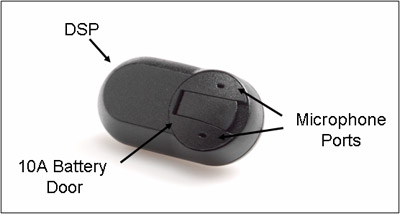
Figure 2: A close-up of the SAM, showing the microphone ports, battery door and the position of the Digital Signal Processor (DSP).
It logs the environment along two major dimensions:
- Sound pressure level as a function of time
- Percentage of time in quiet, speech, speech plus noise, or noise only
The analysis of speech versus noise is based on the TriState Noise Management system first introduced Oticon Syncro in 2004 (Flynn & Lunner, 2004). The stored data from SAM is downloaded and displayed to the audiologist and patient in the form of an Envirogram. Figure 3 provides an example Envirogram that has been downloaded from a SAM device that was worn by a patient. The X axis displays sound pressure level in 10 dB increments. The Y axis provides the percent of time that the patient spent in each of the four types of sound environments.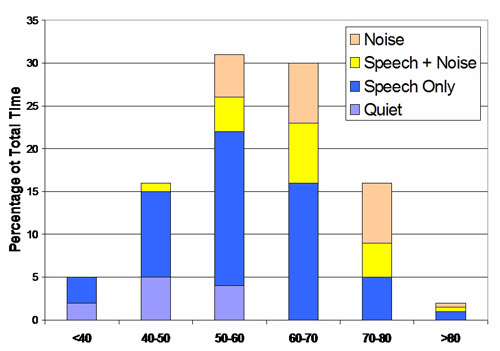
Figure 3: A common pattern of sound levels experienced by a SAM user, this one similar to a normal distribution.
Since the SAM device uses the DSP chip common to the Syncro, Delta and Safran hearing aids, the device is prepared for use and subsequently the data is read using the same cabling (flex connect), Hi-Pro/Noah Link and fitting software as we use with our hearing aids. The data can be viewed in two different software programs: the Genie fitting software or the eCaps Patient education software. Below, we will discuss the reasons why the audiologist may want to use one option or the other.
As can be seen in Figure 2, the SAM device has two microphone ports. The DSP chip used in the device, since it is common with our advanced technology hearing aids, is designed with two microphones in order to implement adaptive directionality. When the data is read by the Genie fitting software, information on the amount of time spent in each of our three directional modes is also available. Of course, since the SAM is worn on the lapel, the directional data is not accurate. However, as discussed below, it can be used to initiate a conversation with the patient about the need for and the benefits of adaptive directionality
How is it Being Used?
The SAM device has been available in the U.S. market since the fall of 2005. Since that time, hundreds of professionals have considered how to incorporate it into daily practice. There are a variety of options ranging from pure clinical data collection to practice marketing. The following are the four most common uses that we have seen for the SAM device. These four approaches are not mutually exclusive. Several professionals have used various combinations of these four approaches.
- Clinical Evaluation Tool: First and foremost, the SAM device provides a new source of data about the patient. The day-to-day life experience of patients varies considerably, and this shows up when the range of sound levels are logged or situational diaries are kept (Jensen, Petersen & Nielsen, 2005). The SAM device provides a convenient way for the audiologist to collect a new source of data about their patients that will have relevance in the selection, adjustment and counseling about hearing aids.
The range and characteristics of the sound environments shown in Figure 3 are the most common pattern we have seen so far. The most common shape of Envirograms is reminiscent of up the Normal Distribution we know from statistics. The most common overall level that patients seem to encounter is in the range of 50 to 70 dB SPL. Sound levels less than 50 or greater than 70 dB SPL are encountered by nearly all patients, but less often then the midrange levels.
Figure 4 provides the second most common pattern we have seen from patients. We refer to this pattern as a "Soft Skew", because the patient tends to find himself in soft to moderate sound environments the majority of the time. Interestingly, this pattern may reflect one of two realities. Either the patient truly encounters moderate to loud environments only a minimal amount of time or, because of the difficulties faced in communicating in more difficult environments, the patient may avoid moderate and loud, noisy environments.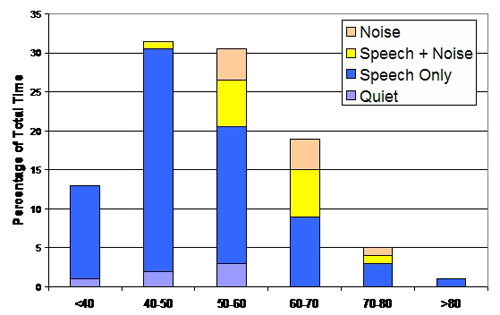
Figure 4: The other common distribution of sound levels, this one skewed towards environments with lower overall levels ("soft skew").
Whether the patient demonstrates a response pattern similar to the one shown in Figure 3 or the one in Figure 4, the data provides important starting point for a discussion of the role of amplification. If the patient has a normal distribution of sound environments, it will be highly likely that, in the moderate and louder environments, speech plus noise will be president a significant percentage of the time. The first step is to discuss with the patient the importance of communicating effectively in such environments. Next, the role of advanced signal processing and amplification to deal with such challenging environments can be introduced.
If the patient demonstrates the soft skew pattern, then a different discussion strategy makes sense. The clinician should probe to determine if the patient has found himself gradually avoiding challenging environments due to the nature of the hearing loss. If that is the case, as it often is, then the importance of amplification can be made clear.
It is important to note that the data by itself tells the audiologist little. The data provided by the SAM must be interpreted in light of the experiences and difficulties expressed by the patient. In this way, the data shown in the Envirogram dovetails nicely with the expressed listening needs that are generated by the application of the COSI. Just as the audiogram does not provide the full picture of the patient's listening difficulties, neither does the Envirogram. However, the audiogram, Envirogram and the COSI provide the clinician with a comprehensive picture of the challenges faced by the patient.
- Patient and Family Educational Tool: Many patients truly want to understand the function of hearing aids. The data provided by the SAM is an excellent way to discuss the design and importance of advanced signal processing and hearing aids.
Essentially all patients will show a range of listening environments from less than 40 to greater than 80 dB SPL. This fact provides a good introduction to the importance of multi-channel compression and hearing aids. Essentially all patients will also show a mix of speech, noise and speech plus noise environments. This reality provides the opportunity to discuss the function of both noise reduction and directionality in hearing aids. Although the directional data from the SAM is not accurate, it does allow for discussion of the general nature of the location of different sound sources and the environment.
As indicated above, the SAM data can be viewed either in our fitting software (Genie) or our patient educational software (eCaps). Figure 5 shows an Envirogram as displayed in the Genie fitting software. Figure 6 shows SAM data as displayed in eCaps. ECaps was developed to use the educational power of multimedia to explain potentially complex technical issues to patients and family members (Beck & McGuire, 2006). Many clinicians have found the technology demonstration pages in eCaps to be an effective way of explaining concepts that have always been difficult for some patients and their loved ones to grasp.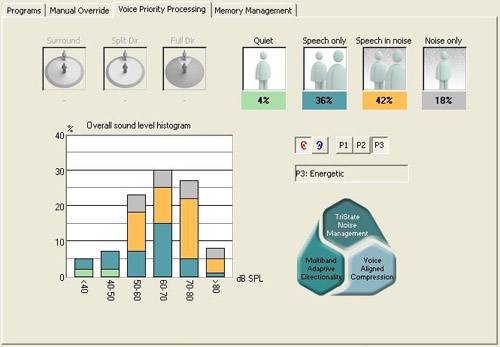
Figure 5: Data downloaded from the SAM and shown in the Genie fitting software.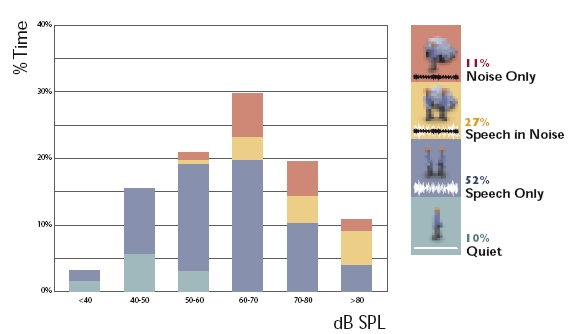
Figure 6: Data downloaded from the SAM and shown in the eCaps patient education software.
There is a natural link between showing the data from SAM and using the patient educational tools in our eCaps program. The Envirogram relates naturally to the sections of eCaps that try to explain advanced signal processing to the patient and family. Although eCaps can be used without a first using the SAM device, the relevance of discussing advanced signal processing will be more apparent to the patient once they realize the range and complexity of sound environments that they face on a daily basis.
Finally, in our Genie fitting software, we offer a function called "Live" in support of our advanced technology hearing aids. The Live function provides real-time reflection of the action of both the noise reduction and directional systems in our hearing aids. Again, there is a natural connection between the data reflected in the Envirogram and the real-time display shown in Live. The clinician can talk about the range of challenging environments that the patient has faced during the logging period and then show how an advanced technology hearing aid would deal with such challenging environments live in the clinic. It is an excellent way for the patient to make the linkage between his real-world experience and the role hearing aids play in providing communication assistance.
- Patient Motivational Tool: There is no doubt that many potential hearing aid users are hesitant about starting the process. As discussed at the outset of this paper, as a field, we need to continually seek out new ways to motivate potential patients to take the first step. We believe the SAM is one such opportunity.
As you know, many individuals with hearing loss will have an initial discussion about the possibility of hearing aids but then decide to wait. Offering to monitor the potential patient's daily environments via SAM is a good way to continue to engage the patient. It should be explained to the patient that the audiogram is only one part of the picture. The impact of a person's hearing loss is only relevant in the context of the environments in which he operates. Therefore the SAM analysis can be profiled as part of the comprehensive evaluation services provided by the audiologist.
For the patient who tends to minimize his listening difficulties, displaying the range of sound environments in the Envirogram is a strategy to help the patient be more forthcoming about his real experienced difficulties. Specifically, an analysis of the speech only versus speech plus noise time periods is an effective way to get the patient to more accurately described the difficulties faced on a day-to-day basis. It is extremely rare to see an Envirogram that does not reflect a significant amount of time spent in speech plus noise situations. When faced with real data, it is more difficult for the patient to minimize his difficulties.
Although the most common use of the SAM is before the patient makes the decision to purchase amplification, some audiologists also use the SAM between the time the hearing aid is ordered and it is fit. The data is used in two ways. First it can give the clinician an indication if the range of sound environments that the patient experiences is dramatically different than normal. If the patient is in very quiet or very loud environments a significant portion of the time, initial adjustments may need to be made in the fitting to reflect these extreme conditions. Secondly, using the SAM between the time of order and the time of fitting is a good way to guard against buyer's remorse. The patient continues to be engaged in the assessment phase and the resulting data reconfirm the importance of advanced technology amplification.
- Practice Differentiation Opportunity: The fourth way to that SAM is being used by audiologists is to profile their practices as progressive. Professionals are always looking for new opportunities to attract patients and to differentiate themselves from other service outlets. Publicly announcing that the audiologist has introduced a new assessment technique into the community is an excellent way of catching the attention of both old and new hearing aid users.
Using the SAM to profile the audiologist's practice as cutting edge can be done using both print and broadcast media. Oticon provides a variety of stock print ads featuring SAM. In addition, we provide stock video footage that can be supplied to local broadcast news stations. During late 2005 and early 2006, the SAM device was featured as part of health or science reports on over 100 stations reaching over 3 million viewers. It has always been difficult to get hearing aid related stories on local TV. It is only when major new developments occur, such as the advent of digital signal processing in hearing aids, that local news stations to take interest. The fact that the SAM device has appealed to so many local reporters indicates how intriguing the concept is to the general public.
Usage Tips
Since the introduction of the SAM device, we have learned a variety of practical tips. For example, it seems that the appropriate amount of time for patient to wear the device before making a final decision about amplification seems to range from a few days to about one week. Anything less may not provide enough data to give a complete picture of the patients typical sound environments. However, if the patient is using the SAM for more than a week, the motivation to continue in the hearing a process may start to decline. Most professionals who have incorporated the SAM device into daily practice for perspective patients schedule a return visit within a calendar week.
Some patients and family members have expressed concerns that the SAM device is actually recording conversations. These individuals should be assured that no actual recordings are being done. Only certain measures of the acoustic environment are being logged.
When relating the data from the SAM device to the patient's daily life, one technique that has proven to be successful is to ask the patient about specific sound environments that he visited during the logging period. For example, if the patient said they visited their favorite restaurant the other evening and it was noisy, that event should show up in the Envirogram as a speech plus noise situation at a level of 70 dB or higher. Linking the SAM data to specific environments is a good technique to show the relevance of that data. It also provides a natural segue into a discussion of the importance of advanced signal processing and amplification to deal with these more challenging environments. Further, it shows the value of keeping the SAM sampling period to a week or less, since the patient's ability to recall details of sound environments will be lost.
Finally, one strategy that is also used is to compare the SAM recordings made prior to the decision to get amplification with the activity analyzer data from Syncro, Delta or Safran made after the patient has had the opportunity to adapt to the new devices. In some cases, if the fitting has been a success, what will be seen is a tendency for the patient to be in a greater range of acoustic environments, especially more of the challenging situations. This is an excellent technique to confirm to the patient the value of obtaining advanced technology amplification.
Final Remarks
At the outset of this article, the SAM device was described as a new tool to potentially motivate more patients to seek treatment. Is there evidence to suggest that this will actually take place? The best of indication of what the SAM device can do is reflected in the number of television spots on local new shows that have featured SAM. Clearly the health and scientific reporters at local new stations see this as a new approach to quantifying the effect of hearing loss. With that sort of interest being shown by the general public, it is not hard to imagine that a person who is aware that he may be having hearing difficulties would also be interested in this sort of assessment prior to making a final decision about getting amplification.
Introducing a new tool into daily audiological practice does not happen easily. Professionals are busy and clinical habits tend to become ingrained. However, historically, when a new tool has been introduced that provides real clinical benefit, professionals have modified day-to-day procedures. Good examples include real ear testing, otoacoustic emission testing, the use of questionnaires such as the COSI or APHAB and adaptive speech in noise testing. These new tools have become widespread because they offered the audiologist real value. The SAM device opens a new window into the lives of our patients and can provide important data for the selection and adjustment of amplification and in the counseling of the patient and family.
More information about the SAM device can be obtained by contacting Oticon, Inc. at 1-800-526-3921 or at www.oticonus.com.
Works Cited
Beck, D.L., and McGuire, R. (2006). MultiMedia: Better Tools Facilitate a Better Process. Hearing Review, May.
Kochkin, S. (2005). MarkeTrak VII: Hearing Loss Population Tops 31 Million People. The Hearing Journal, 12(7), 16-29.
Flynn, M. (2005). Datalogging: A New Paradigm in the Hearing Instrument Fitting Process. The Hearing Journal, 12(3), 52-56.
Flynn, M.C., & Lunner, T. (2004) Clinical evidence of the benefits of Oticon Syncro. News from Oticon, November.
Jensen N.S., Petersen G.S., Nielsen C. (2005). Auditory ecology in a group of experienced hearing-aid users. Paper presented at: Annual Scientific Meeting of the American Auditory Society; Scottsdale, Ariz; March 20-22, 2005.


